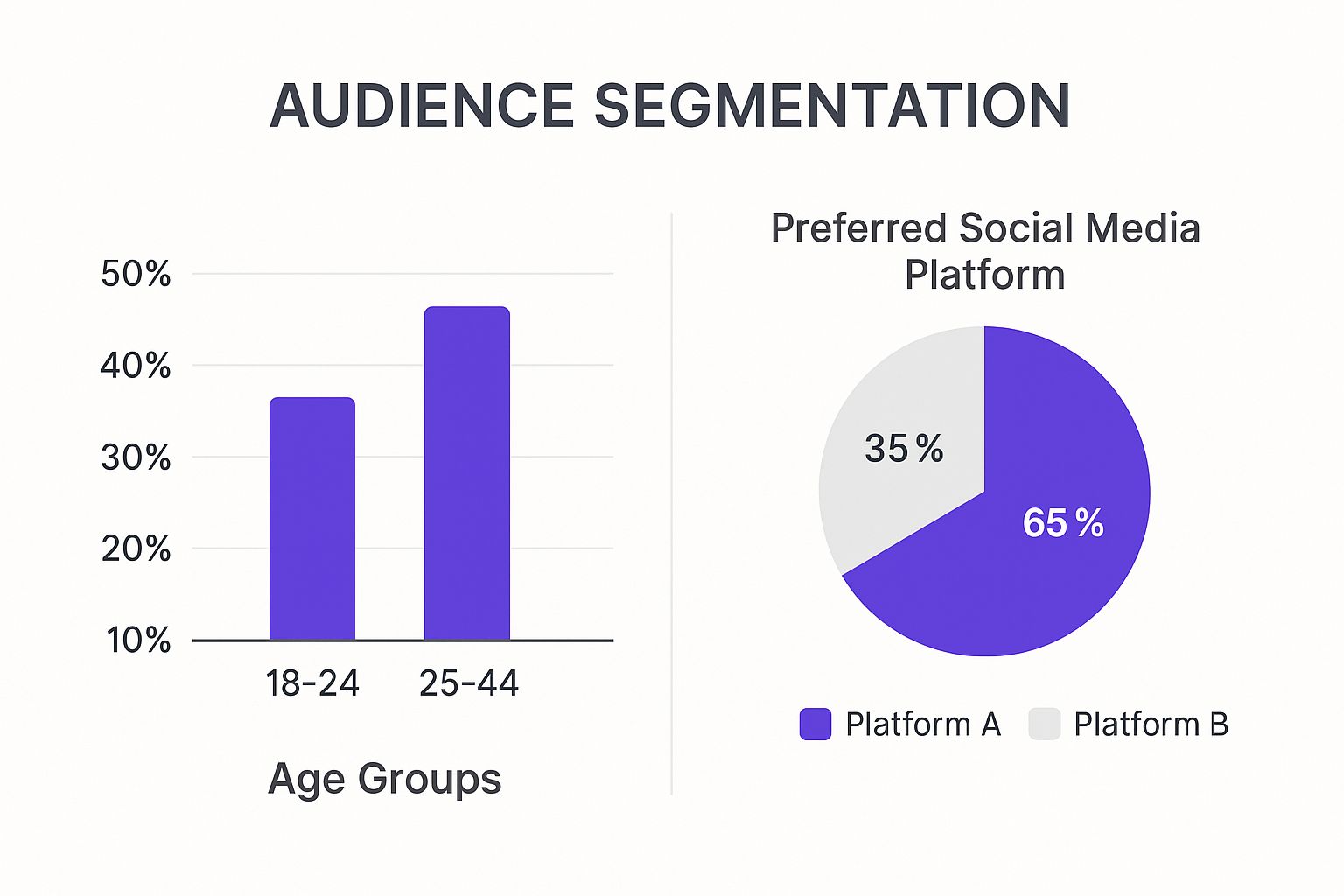Effective Social Media Marketing Strategy Tips
Learn proven social media marketing strategy techniques to boost your brand and achieve real results. Start transforming your approach today!
Posted by
Navigating Today's Social Media Landscape

Today's social media environment is a dynamic and complex space. Brands can easily feel lost, struggling to understand ever-changing algorithms and user expectations. This often results in wasted resources and a disappointing return on investment. However, successful brands are learning to adapt to the constantly shifting patterns of online engagement.
They are focusing on capitalizing on new trends instead of relying on outdated tactics. This proactive approach is the cornerstone of a winning social media marketing strategy.
Understanding User Behavior
Truly understanding user behavior is paramount for any successful social media marketing strategy. What makes users engage with certain content? Why do some posts go viral while others are ignored? These are crucial questions to explore.
It's vital to go beyond simple demographics and dive deeper into the psychology of your target audience. This involves understanding their needs, motivations, and online behaviors. Are they looking for information, entertainment, or connection?
By answering these questions, you can craft content that genuinely resonates with your audience, helping you achieve your marketing objectives.
The Importance of Platform Choice
Selecting the right social media platforms is another key element of a successful marketing strategy. Each platform has unique characteristics, and spreading your resources too thin can be counterproductive. Consider focusing your efforts on the platforms where your target audience spends the most time.
As you examine the social media landscape, remember the specific strategies associated with B2B Social Media Strategy. Think about factors like user demographics, preferred content formats, and the overall culture of each platform. Are your ideal customers mainly on Instagram, LinkedIn, or TikTok?
Concentrating your efforts on the most relevant platforms maximizes your impact and avoids wasting valuable resources.
Adapting to the Evolving Landscape
Social media is in constant flux. New platforms appear, algorithms change, and user behaviors shift. As of early 2025, a staggering 63.9% of the global population actively uses social media every day, spending an average of 2 hours and 21 minutes per day. Find more detailed statistics here.
This widespread usage underscores the importance of social media marketing for reaching vast audiences worldwide. It demands that brands remain adaptable and willing to adjust their strategies as needed.
Staying informed about the latest trends and best practices is essential. This means monitoring new platform features, emerging content formats, and changes in user engagement. For example, the increasing popularity of short-form video content requires creating compelling videos that capture attention quickly.
By embracing change and continuously learning, brands can secure long-term success in the dynamic world of social media. Adaptability isn't just about keeping up; it's about staying ahead.
Selecting Platforms That Actually Deliver Results
Choosing the right social media platforms is essential for a successful marketing strategy. It's not about being on every platform, but about focusing on the platforms where your target audience spends their time. Concentrate your efforts on the platforms that align with your business goals and resonate with your audience.
Identifying Your Target Audience
Understanding your audience is more than just knowing their age, location, and gender. While these demographics are a good starting point, you need a deeper understanding of their online behavior, interests, and motivations. What problems are they trying to solve? What type of content captures their attention? Which platforms do they prefer?

This infographic shows the relationship between age demographics and platform usage. The 25-34 age group is the largest segment, with a preference for Platform A. This data is crucial for making informed decisions about which platforms to prioritize.
Conducting Competitive Analysis
Analyzing your competitors' social media activities can provide valuable information. Pay attention to the platforms they use, the type of content they share, and how their audience engages with it. This analysis can highlight potential opportunities and help you avoid common mistakes. It can also reveal new platforms or content formats you may not have considered.
Evaluating Platform Suitability
Each platform has its unique strengths and weaknesses. Instagram excels at visual storytelling, while LinkedIn is best for professional networking. When evaluating platform suitability, consider your message, content formats, and overall marketing objectives. Choosing the right platform is crucial for effective communication and achieving your marketing goals.
To understand the current social media landscape, consider how platforms like Facebook, Instagram, and X are performing alongside newer platforms such as Threads. Learn more about current social media trends. This dynamic environment requires a flexible strategy that incorporates both established and emerging channels.
The following table provides a comparison of different social media platforms to help you determine which ones might be the best fit for your marketing strategy:
Social Media Platform Comparison for Marketing Strategy
A comprehensive comparison of major social media platforms based on audience demographics, content formats, engagement metrics, and marketing effectiveness.
| Platform | Primary Audience | Content Types | Engagement Rate | Ad Cost Efficiency | Best For |
|---|---|---|---|---|---|
| Platform A | Primarily 25-34 year olds | Images, short videos | High | Medium | Visual storytelling, reaching a broad audience |
| Platform B | Professionals | Articles, long-form videos | Medium | High | Professional networking, thought leadership |
| Platform C | Younger demographics | Short-form videos, interactive content | High | Low | Building brand awareness, viral marketing |
This table summarizes key differences between platforms, highlighting their strengths and weaknesses across different metrics. Choosing the correct platform is paramount to maximizing your marketing ROI.
Embracing Emerging Platforms
While established platforms have large audiences, emerging platforms can offer unique opportunities to engage with a highly active community. Experimenting with new platforms can be beneficial, but it's important to manage your resources effectively. Focus on a few key platforms to build a strong presence and avoid spreading your efforts too thin.
Abandoning Underperforming Platforms
If a platform isn't delivering results, re-evaluate its role in your strategy. It can be tough to abandon a platform, but it's crucial to prioritize those that contribute to your business goals. Focusing on high-performing platforms maximizes your impact and leads to greater success. Consider tools like EndorseFlow to optimize your social media scheduling and improve efficiency.
Crafting Content That Converts Followers Into Customers

Effective social media marketing isn't just about racking up followers and likes. It's about turning those followers into paying customers. This means understanding what motivates your audience to actually take action. This section explores how successful brands create content that converts.
Developing Content Themes That Resonate
A strong social media marketing strategy starts with developing content themes that truly resonate with your audience. This goes beyond simple demographics. You need to understand their interests, needs, and what motivates them. Think about what kind of content provides real value.
For example, if you're targeting small business owners, content on time management or marketing strategies might be highly effective. Developing a series of content themes creates consistency and builds anticipation, fostering a sense of community. Think in terms of campaigns, not just individual posts, to tell a cohesive story.
Building an Effective Content Calendar
A consistent posting schedule is essential for keeping your audience engaged. But consistency doesn't mean posting randomly. A well-structured content calendar helps organize your content and ensures a steady stream of valuable posts. This prevents creative burnout and keeps your social media presence fresh.
A content calendar also allows for strategic planning. You can schedule posts around key dates, events, or product launches. For instance, if you're running a special promotion, scheduling posts in advance can generate excitement and maximize visibility.
Crafting Authentic Calls to Action
Calls to action are crucial for driving conversions. However, they should feel natural and integrated into your content, not forced. Instead of simply telling your audience what to do, explain the benefits of taking action.
For example, instead of "Buy Now," try something like "Discover how this product can save you time and money." Varying your calls to action also keeps your content fresh. Sometimes encourage website visits, other times prompt comments or shares.
The Power of Social Media Investment
Social media marketing is a significant investment for businesses. Global social media ad spending was projected to reach $247.3 billion in 2024, a 14.3% increase from the previous year. Explore this topic further. This highlights the growing importance of social media as a key channel for reaching target audiences.
This investment underscores the need for a well-defined social media marketing strategy. A clear strategy ensures your efforts are focused and aligned with your business goals. By creating content that resonates with your target audience, you can maximize your return on investment and drive real business results. Tools like EndorseFlow can further enhance your strategy by streamlining testimonial collection and automating social media posting.
Precision Targeting That Reaches Decision-Makers

Generic audience targeting wastes your budget and weakens your message. Instead of a broad approach, leading brands are using precision targeting. This method goes beyond simple demographics to connect with real prospects. It involves understanding not only who your audience is but also what they do and why.
Building Effective Customer Personas
Developing detailed customer personas is crucial for precision targeting. A customer persona is more than demographic data; it's a profile of your ideal customer. These personas should be built on real data and market research, not guesses.
For example, a persona might include information about job title, industry, daily work challenges, online activity, and motivations. This in-depth knowledge lets you tailor your content to resonate with specific needs, making it much more effective than generic messaging.
Leveraging Platform-Specific Targeting
Each social media platform offers unique targeting options. Facebook allows targeting based on interests, behaviors, and even life events. LinkedIn excels at targeting professionals by job title, industry, and skills. Understanding these nuances is essential for reaching the right audience.
Also, consider your goals for each platform. Are you building brand awareness, generating leads, or driving sales? Aligning your targeting with your objectives maximizes your social media strategy's effectiveness.
Navigating Privacy Regulations
With increasing privacy regulations, marketers must address the ethical and legal implications of data collection and targeting. This involves being transparent about data usage, obtaining consent, and respecting user privacy.
However, privacy concerns don't eliminate effective targeting. They necessitate a shift toward contextual advertising and interest-based targeting that respects user privacy. Focus on valuable content that organically attracts the right audience.
Testing and Refining Your Targeting
Precision targeting requires continuous improvement. Regularly testing different audience segments and refining your targeting parameters is key. Start small with test campaigns before increasing your investment.
This involves analyzing campaign performance and adapting based on the data. Which segments are engaging? Which are converting into customers? Continuously optimizing your targeting ensures efficient budget allocation.
Aligning Targeting with the Customer Journey
Your targeting strategy should align with the customer journey. For the awareness stage, broader targeting may be suitable. As prospects progress, your targeting should become more focused.
Consider retargeting campaigns to re-engage users who've interacted with your content or website. If someone visits a product page without purchasing, retarget them with ads for that product. This personalized approach boosts conversion rates.
EndorseFlow can streamline your social media marketing. Automating tasks like testimonial collection and posting frees up time for strategic activities like precision targeting. Learn how EndorseFlow streamlines social media management. This enables efficient resource allocation for a more effective social media strategy.
Measuring What Matters: Beyond Vanity Metrics
Likes and followers are great for a quick ego boost, but they don't always tell the full story of your social media success. A truly effective social media marketing strategy requires digging deeper than these vanity metrics and focusing on measurements that show real impact on your business goals. This means identifying the key performance indicators (KPIs) that align with your revenue goals and understanding how to calculate a true return on investment (ROI).
Establishing Meaningful KPIs
Defining the right KPIs is paramount to measuring success. These metrics should directly correlate with your specific business objectives. For example, if your aim is to drive more traffic to your website, prioritize metrics like click-through rates and website referrals from social media. If lead generation is your focus, track metrics like form submissions, email sign-ups, and contact requests originating from your social channels.
Don't forget about engagement metrics like shares, comments, and saves. While not directly tied to revenue, these metrics offer valuable insights into how your audience perceives and interacts with your content. This information can be used to refine your content strategy and improve future campaigns.
Understanding Attribution in Multi-Channel Journeys
It's rare for customers to convert after a single interaction. They might first encounter your brand through a social media ad, then visit your website, subscribe to your email list, and finally make a purchase weeks later. This complex customer journey makes proper attribution crucial. Understanding the role social media plays within this broader context is essential to demonstrating its true value.
Tools like Google Analytics can help you track these multi-channel journeys and attribute conversions more accurately. This provides a clearer picture of how social media contributes to your overall business results.
Calculating Genuine ROI
Demonstrating the ROI of your social media marketing is essential, especially when communicating results to stakeholders. This involves connecting your social media efforts to tangible business outcomes such as sales, leads, and website traffic.
Begin by setting clear, measurable objectives and tracking the associated costs of your social media activities. These costs might include ad spend, software subscriptions, and the time invested by your team. Then, measure the revenue directly generated from your social media efforts. By comparing these costs and returns, you can calculate a genuine ROI.
To help illustrate which metrics to track for different business objectives, take a look at the table below:
Understanding which metrics to track based on different business goals is crucial for demonstrating the relationship between social media activity and business outcomes. The following table provides a breakdown to help guide your measurement strategy:
Table: Social Media Marketing Metrics by Business Objective
A breakdown of which metrics to track based on different business goals, showing the relationship between social media activities and business outcomes
| Business Objective | Key Performance Indicators | Measurement Tools | Reporting Frequency | Success Benchmarks |
|---|---|---|---|---|
| Brand Awareness | Reach, Impressions, Share of Voice | Platform Analytics (e.g., Facebook Insights, Twitter Analytics) | Monthly | Increase in reach and impressions, growth in share of voice |
| Website Traffic | Click-Through Rate, Website Referrals | Google Analytics | Weekly | Improvement in click-through rates, increase in website referrals from social media |
| Lead Generation | Form Submissions, Email Sign-ups | CRM, Marketing Automation Platforms (e.g., HubSpot, Marketo) | Weekly | Growth in leads generated from social media channels |
| Sales | Conversions, Revenue Generated | E-commerce Platform, Analytics Tools | Daily/Weekly | Increase in sales attributed to social media campaigns |
This table highlights the connection between specific KPIs, measurement tools, and various business goals. A targeted approach to measurement provides much more actionable insights than simply collecting a mass of numbers.
Reporting That Demonstrates Business Impact
Effectively communicating your results is just as important as gathering the data. Use clear and concise reports that showcase the impact of your social media strategy on key business objectives. Visualizations such as charts and graphs can make the data easier to understand and more impactful. By focusing on meaningful metrics, proper attribution, and clear reporting, you can build a data-driven social media marketing strategy that delivers real business results. Tools like EndorseFlow can further simplify this process by integrating testimonial collection, social media scheduling, and even an ROI calculator.
Blending Paid and Organic Tactics for Maximum Impact
A truly effective social media marketing strategy recognizes the symbiotic relationship between paid and organic efforts. Instead of operating in silos, these tactics should be interwoven to create a unified ecosystem where each bolsters the other. This synergistic approach maximizes reach and impact, creating a powerful combined force.
Testing Organic Content Before Paid Amplification
One of the most practical applications of this blended approach is using organic content as a testing ground. Think of your organic posts as a preliminary focus group. By publishing content organically first, you gather valuable data on audience resonance before investing in paid promotion.
This organic testing reveals what truly connects with your audience: content themes, formats, and effective calls to action. For example, high organic engagement on a particular post signals its potential for successful paid amplification. This data-driven approach optimizes ad spend and improves overall ROI.
Retargeting Engaged Organic Audiences
Organic engagement provides crucial insights into audience interests. This information can then fuel highly targeted paid campaigns. You can retarget users who have interacted with your organic content, presenting them with tailored ads aligned with their demonstrated interests.
This strategy is especially effective for moving prospects through the sales funnel. Someone who liked a post about a specific product might be receptive to an ad featuring a special offer or a direct link to purchase.
Leveraging Paid Insights to Improve Organic Content
The data gleaned from paid campaigns can also enhance your organic content strategy. Paid campaigns offer valuable information about audience demographics, interests, and behaviors. Use this data to create more relevant and engaging organic content.
For instance, a successful paid campaign targeting a specific demographic can inform the creation of organic content tailored to that same audience segment. This cross-pollination of insights establishes a feedback loop of continuous improvement.
Framework for Budget Allocation
Many businesses mistakenly treat paid and organic social media as separate budget items. A more effective approach is to view them as two parts of a cohesive whole. Develop a budget allocation framework that maximizes overall performance, not just individual channel performance.
One effective strategy is allocating a portion of your budget to organic content creation and community building, while dedicating another portion to amplifying high-performing organic content with paid promotion. This balanced approach ensures a consistent presence while maximizing reach and impact.
Maintaining Consistent Brand Voice
Consistency is paramount in social media marketing. Whether it’s a paid ad or an organic post, maintain a consistent brand voice. This creates a unified brand experience for your audience, building trust and recognition.
Develop clear brand guidelines encompassing tone, style, and messaging. Apply these guidelines to all social media activity, regardless of whether it's paid or organic. This ensures a cohesive brand identity across all platforms. You might be interested in: How to master social media management best practices. This link offers further insights into cultivating a consistent and engaging social media presence.
By blending paid and organic tactics effectively, you create a powerful synergy that drives business results. Remember, these approaches are not mutually exclusive but complementary components of a comprehensive social media marketing strategy.
Future-Proofing Your Social Media Marketing Strategy
The social media world is constantly evolving. For brands to truly succeed, they need to be proactive, anticipating changes rather than simply reacting to them. This involves more than just keeping up with fleeting trends; it requires a dynamic social media marketing strategy that can adapt to shifting user behaviors and emerging technologies.
Adaptable Frameworks for an Ever-Changing Landscape
A future-proof strategy begins with adaptable frameworks. These frameworks should define core principles and processes that remain effective no matter how specific platforms change. For example, understanding your target audience and delivering valuable content will always be crucial, even as platforms and algorithms evolve.
This means building a core strategy grounded in the enduring principles of marketing and communication. This strong foundation will guide your decision-making, even when faced with the latest platform updates or features.
Evaluating Emerging Platforms and Features
The social media landscape is constantly growing, with new platforms and features appearing regularly. It's crucial to have a system for evaluating these new developments. Not every new trend deserves your time and resources.
Establish a clear set of criteria for assessing new platforms and features. Consider factors such as audience alignment, potential return on investment (ROI), and the resources required. This methodical approach will prevent you from chasing short-lived fads.
Maintaining Brand Consistency Across Evolving Environments
Maintaining brand consistency is essential, even as platforms change. Your brand identity – your voice, messaging, and visual style – should remain consistent across all channels. This creates a recognizable and trustworthy experience for your audience.
Develop comprehensive brand guidelines and ensure they're applied consistently across all platforms. This consistency strengthens brand recognition and builds audience loyalty, no matter where they interact with your brand.
Building Institutional Knowledge to Prevent Repeating Past Mistakes
Learning from past experiences is vital for future success. Implement systems for documenting lessons learned, both successes and failures. This institutional knowledge helps avoid repeating past mistakes and informs future strategies.
This might involve creating a central repository for campaign performance data, best practices, and post-campaign analyses. This readily accessible information becomes a valuable resource for future campaigns and onboarding new team members.
Staying Informed Without Getting Distracted
Staying current with industry developments is important, but it's easy to get overwhelmed. Focus on reliable sources that offer valuable insights, not just passing trends. This curated approach keeps you informed without losing focus.
Subscribe to industry newsletters, follow reputable blogs like Neil Patel, and engage with thought leaders. Be selective about the information you consume to avoid information overload and concentrate on significant changes.
A future-proof social media marketing strategy is about building a solid foundation that can stand the test of time. By focusing on adaptable frameworks, consistent branding, and continuous learning, you can navigate the ever-shifting social media landscape and achieve lasting success. EndorseFlow, with its integrated platform for testimonial collection, social media scheduling, and ROI tracking, can be an invaluable tool in building and executing this type of strategy. Learn more about how EndorseFlow can empower your social media marketing.